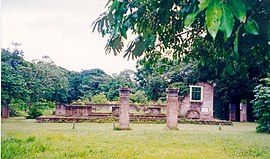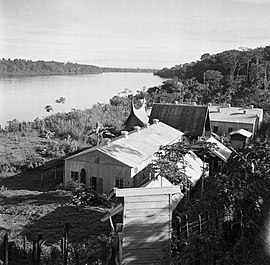Iodine savannah
| Iodine savannah | ||
|---|---|---|
|
Coordinates: 5 ° 25 ′ N , 54 ° 58 ′ W Iodine savannah on the map of Suriname
|
||
| Basic data | ||
| Country | Suriname | |
| District | Para | |
| Detailed data | ||
| Waters | Suriname | |
| Time zone | UTC −3 | |
| Jodensavanne, Benoit 1830 | ||
| Remains of the synagogue on Jodensavanne, February 2000 | ||
| Remnants of the Kamp Jodensavanne in 1947 | ||
Jodensavanne ( Dutch , Judensavanne) is a former residence of Sephardic Jews in Suriname , about 50 kilometers south of Paramaribo . The place is in the district of Para on the right bank of Suriname . Iodine savannah was also referred to as "Jerusalem on the river". It has not been inhabited since a devastating fire in 1832.
colonization
The first Jews settled here as early as 1640 on the Cassipora stream, a tributary of the Suriname. The Jodensavanne is one of the oldest and most important settlements for Jews in the New World. They had fled Spain and Portugal from persecution by the Inquisition and began to plant and plant sugar cane plantations . Under the first successful European colonizer of Suriname, Lord Francis Willoughby of Parham , a second group of English Jews came to Suriname via Barbados in 1652 . A third group came to Suriname from Mauritsstad (Moritzstadt, today Recife ), ( Brazil ) in 1664 under the direction of David Nassy . They had originally fled from Spain to Dutch Brazil and had planted sugar cane plantations there under Governor Moritz von Nassau together with the Dutch. When the Dutch territory in Brazil was recaptured by the Portuguese in 1654, a large part of the Jews fled again. Some settled in the Cayenne colony, (today's French Guiana ), in Guadeloupe and in Suriname. When the French conquered the former Cayenne colony in 1664, the Jews from this area also moved to Suriname.
Free exercise of belief
On August 17, 1665, the Jewish community in Suriname received the right to freedom of worship and the right to found a synagogue and a school. When Abraham Crijnssen conquered Suriname from the English in 1667, he did not affect the rights granted to the Jews under Lord Francis Willoughby. In 1669 the Jews were officially approved to establish a colony with a synagogue and a cemetery . This new settlement, a few kilometers north of the Cassipora, was later named Jodensavanne . After the first wooden synagogue was built between 1665 and 1671, a stone synagogue was built here in 1685, which was named Beraha VeShalom ("Blessings and Peace").
At the end of the 17th century, the Jewish community around the savannah consisted of around 700 members. At that time they owned 40 plantations, on which around 9,000 slaves worked. When the iodine savannah was almost completely devastated by arson in 1832 , the last inhabitants left the area and moved to Paramaribo.
Second World War
During the Second World War , a concentration camp ( Kamp Jodensavanne ) was built in the Dutch colony of Suriname under Governor Johannes Coenraad Kielstra near Jodensavanne . In September 1942 146 actual or supposed supporters of the National Socialist Movement (NSB) from the Dutch East Indies were interned here. In July 1946 the camp was disbanded and the 138 survivors returned to the Netherlands.
Foundation, endowment
After 1967, the Dutch colonial army (Troepenmacht in Suriname, TRIS) had exposed the place in the jungle, the architect Chin A Djie 1971 developed a plan to preserve the Jodensavanne for posterity. The Jodensavanne Foundation (SJS) was established for this purpose on October 11th . Two years later the area was cleared again. The remains of the synagogue were uncovered and a visitors' pavilion was built. During the civil war (1986 to 1992) the area was contested and neglected. Only in 1999 was the iodine savannah freed from the overgrown vegetation and made accessible to visitors.
World Heritage
On June 30, 1998, an application ( tentative list ) was submitted to UNESCO for recognition of the iodine savannah and the Cassipora cemetery as world cultural heritage . [outdated]
literature
- Michael Studemund-Halévy : Jodensavanne. In: Dan Diner (Ed.): Encyclopedia of Jewish History and Culture (EJGK). Volume 3: He-Lu. Metzler, Stuttgart / Weimar 2012, ISBN 978-3-476-02503-6 , pp. 203-207.
- Cynthia McLeod : Suriname. German edition of Hoe duur was de suiker? , Verlag Nymphenburger, Munich 1996, ISBN 3-485-00744-7 .
- Twan van den Brand: De penal colony. Een Nederlands concentratiekamp in Suriname 1942-1946 , Uitgeverij Balans, Amsterdam 2006, ISBN 90-5018-808-7 .
Web links
- Jodensavanne Foundation
- A Star Historian Opens a New Chapter: Jewish Slaveowners
- Larry Luxner: For Rent , Jewish General , July 6, 2006
Individual evidence
- ↑ Kamp Jodensavanne , Dutch, accessed September 4, 2016.
- ↑ Application for entry in the list of world cultural heritage , in English, accessed on September 4, 2016.



